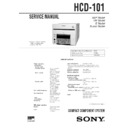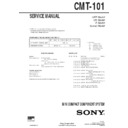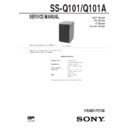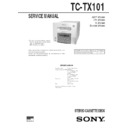Sony CMT-101 / HCD-101 / TC-TX101 Service Manual ▷ View online
HCD-101
AEP Model
UK Model
E Model
Tourist Model
SERVICE MANUAL
COMPACT COMPONENT SYSTEM
MICROFILM
Model Name Using Similar Mechanism
NEW
CD Mechanism Type
CDM50
Optical Pick-Up Type
KSS-313A
SPECIFICATIONS
— Continued on next page —
• HCD-101 is the CD PLAYER,
TUNER and AMPLIFIER
sections in CMT-101.
sections in CMT-101.
Tuner section
Tuning range
2 band model
European model:
European model:
FM : 87.5-108MHz
(50kHz step)
AM : 522–1,611kHz
(50kHz step)
AM : 522–1,611kHz
Other models:
FM : 87.5–108MHz
(50kHz step)
AM : 531–1,602kHz
(at 9kHz interval)
530–1,710kHz
(at 10kHz interval)
(50kHz step)
AM : 531–1,602kHz
(at 9kHz interval)
530–1,710kHz
(at 10kHz interval)
3 band model
FM : 87.5–108MHz
(50kHz step)
MW : 522–1,611kHz
(at 9kHz interval)
LW : 144–288kHz
(at 3kHz interval)
(50kHz step)
MW : 522–1,611kHz
(at 9kHz interval)
LW : 144–288kHz
(at 3kHz interval)
Intermediate frequency
FM : 10.7MHz
AM : 450kHz
AM : 450kHz
Aerial terminals
FM : 75
Ω
unbalanced
AM : External aerial
terminal
terminal
Timer
Quartz lock system
Timer setting
One-minute step
Sleep timer
10–minute step, max.
90minutes
90minutes
CD player section
System
Compact disc digital
audio system
audio system
Laser
Semiconductor laser
(
(
λ
=780nm)
Laser output power
Less than 44.6
µ
W*
* This output is the value measured at a distance of 200mm from
the objective lens surface on the optical pick-up block with 7mm
aperture.
aperture.
Frequency response
5Hz–20kHz
Signal to noise ratio
More than 90dB
Harmonic distortion
Less than 0.05%
Amplifier section
European model:
DIN power output
15+15 W (4
Ω
at 1kHz, DIN
Continuous RMS power output
21+21 W (4
Ω
at 1kHz, 10%
THD)
Music power output
26+26 W
Other model
Rated RMS power output
16+16 W (4
Ω
at 1kHz, 1% THD,
AC240V/AC120V)
Reference RMS power output
22+22 W (4
Ω
at 1kHz, 10% THD,
AC240V/AC120V)
Inputs
VIDEO/PC IN jack : Stereo
phone jack, sensitivity 500mV,
impedance 47k
phone jack, sensitivity 500mV,
impedance 47k
Ω
— 2 —
SAFETY-RELATED COMPONENT WARNING!!
COMPONENTS IDENTIFIED BY MARK
!
OR DOTTED LINE WITH
MARK
!
ON THE SCHEMATIC DIAGRAMS AND IN THE PARTS
LIST ARE CRITICAL TO SAFE OPERATION. REPLACE THESE
COMPONENTS WITH SONY PARTS WHOSE PART NUMBERS
APPEAR AS SHOWN IN THIS MANUAL OR IN SUPPLEMENTS
PUBLISHED BY SONY.
COMPONENTS WITH SONY PARTS WHOSE PART NUMBERS
APPEAR AS SHOWN IN THIS MANUAL OR IN SUPPLEMENTS
PUBLISHED BY SONY.
TABLE OF CONTENTS
1.
GENERAL
······································································ 3
2.
DISASSEMBLY
2-1.
Case ···················································································· 4
2-2.
Front Panel Section ···························································· 4
2-3.
PRE Board ·········································································· 5
2-4.
Function board, Relay board, SP TM board, Trans board,
Power board ········································································ 5
Power board ········································································ 5
2-5.
Mechanism Deck ································································ 6
2-6.
Chassis (T2) Assy ······························································· 6
2-7.
BD Board ············································································ 7
2-8.
Roller Arm Block Assy ······················································· 7
2-9.
Chassis (OPT), Chucking Arm Assy ·································· 8
2-10. Motor (SL) Assy (M102), Optical Pick-Up ························ 8
3.
TEST MODE
·································································· 9
4.
ELECTRICAL ADJUSTMENT
······························ 11
5.
DIAGRAMS
5-1.
Circuit Boards Location ··················································· 14
5-2.
Block Diagram ································································· 15
5-3.
Schematic Diagram –BD Section– ··································· 18
5-4.
Printed Wiring Board –BD Section– ································ 21
5-5.
Printed Wiring Board –Panel Section– ····························· 23
5-6.
Schematic Diagram –Panel Section – ······························ 25
5-7.
Printed Wiring Board –PRE Section– ······························ 27
5-8.
Schematic Diagram –PRE Section– ································· 29
5-9.
Printed Wiring Board –Function Section– ······················· 31
5-10. Schematic Diagram –Function Section– ·························· 33
5-11. Printed Wiring Board –Power Section– ··························· 36
5-12. Schematic Diagram –Power Section– ······························ 39
5-13. IC Pin Function ································································ 42
5-14. IC Block Diagrams ··························································· 44
5-11. Printed Wiring Board –Power Section– ··························· 36
5-12. Schematic Diagram –Power Section– ······························ 39
5-13. IC Pin Function ································································ 42
5-14. IC Block Diagrams ··························································· 44
6.
EXPLODED VIEWS
6-1.
Front Panel Section ·························································· 47
6-2.
Chassis Section ································································· 48
6-3.
Mechanism Deck Section-1 (CDM50) ····························· 49
6-4.
Mechanism Deck Section-2 (CDM50) ····························· 50
7.
ELECTRICAL PARTS LIST
··································· 51
Outputs
VIDEO/PC OUT jack : Stereo phone
jack, 250mV, 1k
jack, 250mV, 1k
Ω
DIGITAL OUT (CD OPTICAL OUT):
Square optical connector jack, –18dBm,
wave jength 660nm
PHONES (headphones) jack :
Stereo mini jack, accepts head phones of
8
Square optical connector jack, –18dBm,
wave jength 660nm
PHONES (headphones) jack :
Stereo mini jack, accepts head phones of
8
Ω
or more.
General
Power requirements
European model
220–230V AC, 50/60Hz
Other models
110–120V or 220–240V
AC, 50/60Hz adjustable
with voltage selector
AC, 50/60Hz adjustable
with voltage selector
Power consumption
66W (when connected to TC-TX101,
MDS-MX101)
MDS-MX101)
Dimensions
Approx. 142
×
125
×
260mm (w/h/d) incl.
projecting parts and controls
Mass
Approx. 4.1kg
NOTES ON HANDLING THE OPTICAL PICK-UP
BLOCK OR BASE UNIT
BLOCK OR BASE UNIT
The laser diode in the optical pick-up block may suffer electrostatic
break-down because of the potential difference generated by the
charged electrostatic load, etc. on clothing and the human body.
During repair, pay attention to electrostatic break-down and also
use the procedure in the printed matter which is included in the
repair parts.
The flexible board is easily damaged and should be handled with
care.
break-down because of the potential difference generated by the
charged electrostatic load, etc. on clothing and the human body.
During repair, pay attention to electrostatic break-down and also
use the procedure in the printed matter which is included in the
repair parts.
The flexible board is easily damaged and should be handled with
care.
NOTES ON LASER DIODE EMISSION CHECK
The laser beam on this model is concentrated so as to be focused on
the disc reflective surface by the objective lens in the optical pick-
up block. Therefore, when checking the laser diode emission,
observe from more than 30 cm away from the objective lens.
the disc reflective surface by the objective lens in the optical pick-
up block. Therefore, when checking the laser diode emission,
observe from more than 30 cm away from the objective lens.
Notes on chip component replacement
•
Never reuse a disconnected chip component.
•
Notice that the minus side of a tantalum capacitor may be damaged
by heat.
by heat.
Flexible Circuit Board Repairing
•
Keep the temperature of soldering iron around 270 ˚C during
repairing.
repairing.
•
Do not touch the soldering iron on the same conductor of the
circuit board (within 3 times).
circuit board (within 3 times).
•
Be careful not to apply force on the conductor when soldering or
unsoldering.
unsoldering.
SERVICE NOTE
— 3 —
SECTION 1
GENERAL
This section is extracted
from instruction manual.
from instruction manual.
1 Remote control signal sensor
2 Power switch
3 CD insertion slot
4 Display window
5 6 (CD EJECT) button
2 Power switch
3 CD insertion slot
4 Display window
5 6 (CD EJECT) button
6 PHONES terminal
7 BAND button
8 DBFB button
9 =0/)+ (Cue-up musics, or fast rewind / fast
7 BAND button
8 DBFB button
9 =0/)+ (Cue-up musics, or fast rewind / fast
forward) button
0 VOL+/– button
!¡ ^ (CD playback or pause) button
!¡ ^ (CD playback or pause) button
!™ FUNCTION button
!£ p (CD stop) button
!£ p (CD stop) button
— 4 —
SECTION 2
DISASSEMBLY
2-1.
CASE
1
Two screws (Case 3 TP2)
1
Two screws (Case 3 TP2)
2
Remove the case upward in the
direction of the arrow.
2-2.
FRONT PANEL SECTION
3
Wire (Flat Type)
(27 Core)
5
Front panel section
4
Connector
(CN916)
1
Two screws
(BV/Ring S Tight)
2
Pull the front panel out.
claw




